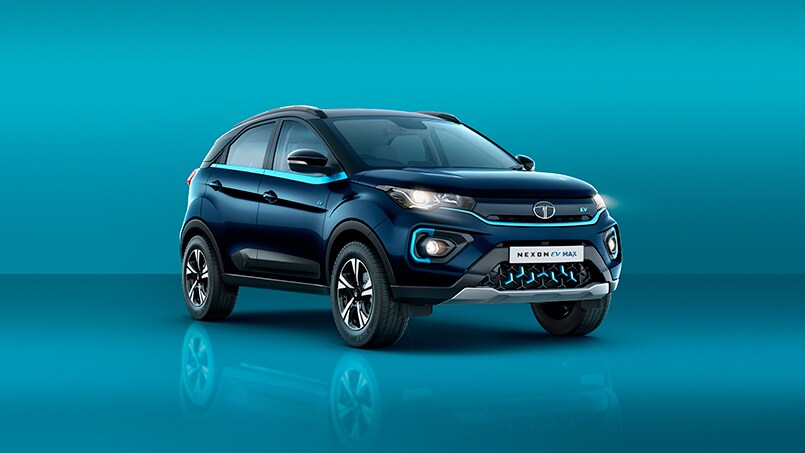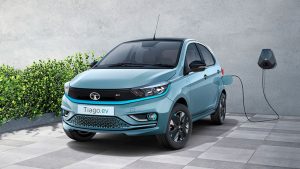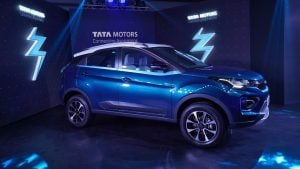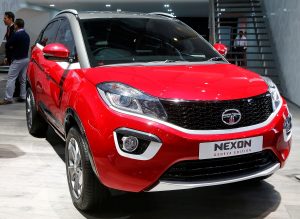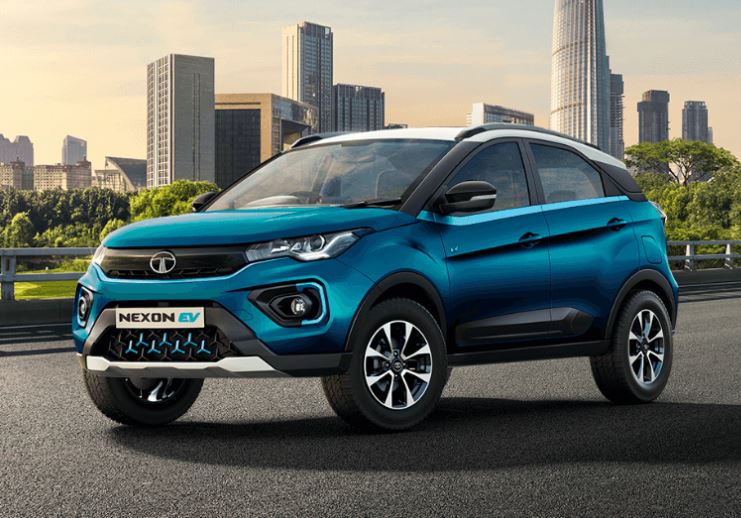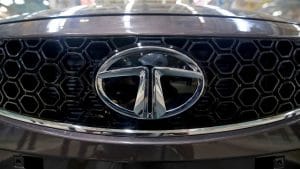Storyboard18: ‘55% of Nexon customers are first-time buyers,’ Shailesh Chandra, Tata Motors

KV Prasad Jun 13, 2022, 06:35 AM IST (Published)
 Listen to the Article (6 Minutes)
Listen to the Article (6 Minutes)
Summary
In an in-depth conversation with Storyboard18, Tata Motors’ MD, Chandra talks about everything from electrification and SUVs driving growth to retail strategies in the south and JLR collabs.
Shailesh Chandra, managing director, Tata Motors PVs and Passenger Electric Mobility, is steering the company through one of the most disruptive periods in the auto industry, with the advent of electric mobility. In an in-depth interview with Storyboard18’s Delshad Irani, Chandra talks about Tata Motors’ star brand – Nexon, TaMo’s evolution as a cool SUV-maker, EV opportunities and challenges, virtual commerce and accelerated retail strategy in the South and in rural markets. Chandra also spotlights their collaborations with Jaguar Land Rover (JLR) to create a future-ready product pipeline.
Read on for more and other interesting tidbits including the answer to why so many of Tata Motors’ EV customers in southern markets are doctors.
Edited for clarity.
Tell us about the star brand in Tata Motors’ portfolio – Nexon. What are the key product, marketing and brand strategies that have helped propel Nexon’s growth and what is its role in the overall growth story and on the road ahead?
Nexon as a brand has been pivotal to our growth. We are seeing certain segments where the growth is more. Our SUV portfolio is much stronger than the other segments and this is a trend which we have been seeing over a period of time.
Consumers in general are different from what they were earlier in the country and therefore we are trying to align our portfolio and our brand pillars to how the consumer choices are also changing. Customers earlier used to look for the practical and rational in products – movement from point A to B, fuel efficiency… Today, a car is an object of self expression. You have consumers who are younger – over 60 per cent consumers who are less than 35 years old, and there’s a higher consciousness around safety as well as environment.
Also Read | Storyboard18: Unacademy on hybrid education model, expansion plans; battle for IPL media rights and more
So based on these changing values we have focused on three brand pillars for ourselves. These are making our cars very expressive, therefore our focus on design. Safety, which I must say we have pioneered in this country. And the third one is, of course, we bring the right balance of features and driving electrification in the country. These are the few pillars on which we are building the brand aligning to the consumer need.
Nexon is the flagship product which is pronouncing these pillars the best in our portfolio.
Design, engineering or brand – what matters most to the end consumer today?
It is always a mix of all these factors. But one thing which we are clearly seeing is that design and stylishness is becoming more important. People were absolutely happy with very functional, boxy cars, but today they are looking for character. They are looking for more safety and they are willing to pay for safety. The pandemic has made people more conscious of their safety and well-being.
Engineering, which is more around performance, the handling of product and all, is an aspect which is more hygiene. In a nutshell, it’s more appreciation for stylishness and expressive design. And of course, greater focus on safety and environment. Aspects like performance, fuel efficiency and maintenance cost are now hygiene factors.
The Tata brand name carries a lot of significance and weight. So when it comes to your individual brands, are consumers buying a Tata vehicle or are they buying a Nexon or a Harrier?
It’s both. They buy a Tata car for its local manufacturer pride and for the trust. But at the same time each brand and product is a different character on its own. The Safari, for example, was the first lifestyle SUV brought in the country and many people who have lived in those times have this inner aspiration of always owning a Safari. So you have those kinds of brands which people connect to. Then you have a product like Nexon which even a lot of women consumers love because of its safety, a better commanding height and those kinds of aspects. So people are buying our cars because of the trust in the Tata brand, the pride of a local manufacturer and, of course, what these individual name plates mean to them.
Once there were cars like Tata Nano and Indica and that evolved into a fleet model. Now you have brands like Hexa, Harrier and Nexon, and suddenly you are this affordable yet cool SUV brand. Tell me about how this evolution happened.
I was surprised when I saw the data of Nexon which is a Rs10 lakh kind of car. 55% of our customers are first-time buyers. We used to always think that they would buy an entry car as their first car. Young people are spending more and the population of consumers who are young and car buyers who are young is increasing every day. Therefore, we have to align our portfolio with their choices. This was one part which was at the centre of our consideration when we were thinking of our portfolio.
Also Read | Storyboard18 | Men like Rosé & women like single malts – that’s the new normal: Ipsita Das, Moët Hennessy India
Young consumers don’t have a cost-of-ownership approach. Just like they use other things to express themselves, they want to be seen in a car which is more expressive. So design became one of the important themes for us.
There was this global trend of movement towards SUVs and we always saw in India also that when an SUV was offered at a certain price point in the market, it was more acceptable. It was always aspirational. Then there are the practical benefits of an SUV with a commanding height, better ground clearance and all, just helps in the Indian kind of driving environment.
Keeping all this in focus is how we went about our portfolio, which is more SUV focused. We brought SUVs from a subcompact like a Punch to a Nexon. So we have the widest portfolio which is why 69-70% of our volumes are SUVs as compared to industry share of 40%. This is how we imagined our portfolio and aligning to how we are seeing the changes in consumer preferences.
Where is the growth coming from and where will it come from in the near future?
SUVs is one segment where the growth will continue and where the launch actions will be more intense. The other growth area would be in the powertrains. Electrification and more eco-friendly powertrains will start getting pace and we are already witnessing the steep growth. CNG or electric, these kinds of powertrains and you continue to see a growth which will be coming from these two areas. Slowly products will get less emphasis on growth and powertrains will get bigger. So electrification is going to see bigger growth in the coming times.
As Tata Motors we are at the sweet spot of both, in SUVs and in powertrains. With all the eco-friendly powertrains and electrification in any case, we are leading the charge in this space and therefore in future you will see more models as we have announced in electric vehicles, more CNG models will come and a few more products maybe in SUVs going forward.
In your view, what are the biggest challenges to marketing an electric future to Indians? And how do you plan to overcome these hurdles?
The good thing is that Indian consumers adopt things very fast. If you ask 10 people, seven or eight of them would say that I’m really thinking of an electric vehicle but I’m curious to know about electric cars.
What holds them from buying an electric car today? You have about 120-140 options available in the conventional world of ICE. But there’s only a handful of options in EVs. So the choices are less and they are less in terms of body styles, pricing and affordability levels.
The second aspect is a lot of myths and certain bottlenecks in terms of charging. Based on all cars that we have sold in the EVs space, 96% of the time people charge at home. So the awareness of people that cars can be actually charged at their home, similar to how people charge their mobile phones overnight, is not there. This awareness also needs to be created. And it’s not that stressful. The charging issue is an overstated issue. Within the city, you actually don’t need public charging. But on highways it’s a challenge. You need more chargers to make it a more practical solution.
But what we have seen in the last one year with home charging solutions available; earlier the first car buyer or primary car buyer for electric used to be just 25-30% for our Nexon EVs today it is 60-65%.
So a few things have to be taken care of to really make the electric vehicles fly in terms of adoption – more choices, slightly more range, greater awareness and charging infra on the highways. If we are able to take care of all these things, then you’d ask why would you not buy an electric vehicle? They are silent, not polluting, better in performance, lower in total cost of ownership and you get an eight year warranty.
I mean there will be no reason why you would consider a conventional car if those aspects are taken care of. So those are the challenges we need to overcome.
It also puts you in a strange position because you still have to sell conventional cars. So how do you balance that view on these two ends?
It’s a very clear view. We have to try our best to see how fast we can accelerate electrification because that’s the future and that’s what the nation needs. That’s what everyone needs. But the challenge is that the whole ecosystem development will take its own time.
Today, auto volumes are 100 million cars and electric vehicles are 2 million or so. So you have a big journey of scaling up the operations. And operations are not about only putting on capacity for car manufacturing, it goes down to mines. It goes down to the charging infra that you have to create. It’s going to take its time. But you cannot not serve the 98 million. So, you have to therefore produce ICE vehicles.
If I take a 10 year view, 30% is what is projected as the penetration of electric vehicles even if you speed up, and 70% is still going to be ICE. Our attempt would be that we should be much more than this 30%. We should be closer to 50% as a company and the remaining 50% of whatever conventional vehicles we are going to make are more eco-friendly like CNG and those kinds of options. That’s the only practical way forward…
Will performance become commoditized with the arrival of battery-powered EVs? What will you do to stay ahead in the EV game?
It is becoming more hygiene as compared to making products more expressive, more aligned toward digital and tech-savvy consumers. So with those elements of a connected car and packed with high-tech features, performance will definitely take a backseat because it becomes a hygiene factor. It will be only for certain niche categories that you need performance still as a big differentiator. You are in a way right that performance is going to become more hygiene as compared to a big differentiator that it used to be earlier, with the electric cars that are coming in.
How are we going to continue to lead the charge on electric vehicles? We are going fast and in a very firm and sure manner. We have already announced that we are going to invest nearly $2 billion in the next 5-6 years coming with 10 products. Gen 1, gen 2 and gen 3 which would mean born EVs. Gen 1 is the current conversion product. And then you’ll have a more electrified, electric-ready product or a platform approach that we go with.
So 10 products at different price points, more choices in terms of body stylings, these are some things that we will have to give in the market to remain a leader and this is what we are planning to do.
What have you done in the virtual commerce space?
In the past two years, we made the digital journey for a consumer more stronger. We launched a click-to-drive initiative with an imaginator kind of concept, and you could evaluate, book and purchase your car online. Today a greater portion of our pipeline of inquiries come from digital. This was one big thing that we did to make it more convenient for a customer to shop from home.
We also started in a big way hyperlocal marketing, where we standardized the website through Google My Business for all the dealers which allowed a local-level focus and allowed ratings to be done for individual dealers. So, consumers went with a clearer understanding of the experience that they can expect from a certain dealer and therefore that also enables greater connection at a local level. It helped our conversions to a much larger extent.
On the other hand, you also launched a rural marketing initiative, a doorstep showroom-on-wheels.
The rural market initiative which we call Anubhav, is these trucks that travel to remote locations, places where there is no critical mass to support a profitable or viable showroom in those areas. But still consumers need an in-person connection, where you can see the car and you have someone explaining the features. It’s very early days to really see the benefit of this. We are keeping our fingers crossed. But that should really help us go very fast in the rural areas.
Tell us about your accelerated retail strategy in southern markets? How is that working out?
We have been growing very fast in the last two years, and we have set our aspirations to grow fast. We’ve grown nearly two and a half times in less than two years, when the industry has grown by about 10% or so. To meet this aspiration we had to also expand our presence in the network otherwise we would not have been able to scale up our system.
So one was to support growth. The other one was that we had to give an opportunity to our current dealers also to expand and capture more volumes from adjacent areas. A lot of this addition has come in rural areas. Also, in certain zones our growth has been more than a pan-India average. A more aggressive strategy for network expansion has really helped us grow our volumes and in certain zones where we had become weaker because of the exit of certain channel partners, we had to immediately refill that. So it has been a mix of all these things which has led us to expand our network at a very accelerated pace. We have added roughly 250 outlets in a year and we want to further add similar kinds of outlets in 2022.
What sets apart the Southern markets in your view?
Every region is very different. For example, North and West you see a major surge coming from CNG. There’s more demand for SUVs when you go into the south. You see nuances also in the south. We have seen a major growth in states like Kerala and not just for more SUVs, but electric as well as smaller cars like Tiago and Tigor. SUVs are slightly better in the southern markets in certain states as compared to others. Nexon, Altroz and Tiago are doing really well in markets like Kerala. EVs, for example, are really doing well in the South, in both Kerala and Karnataka and in cities like Hyderabad where we’re seeing a major explosion of EVs also.
Is it also a matter of more maturity of those markets?
If you see the natural cohorts for EVs, we have identified 3-4 of them. First is customers who are fitness inclined, who also typically care a lot for nature. Then there are digital natives who are working in the digital and tech world. Third is customers who we used to call ‘maintenance seekers’ who want hassle-free ownership experience. The fourth cohort is people who buy EVs to show themselves as responsible citizens. These are customers who are affluent, possibly own a luxury car, but also want to be seen in green cars. So these are the four categories and if you just try to imagine all these kinds of categories people and especially the digital world and tech people, more of this population is in the South. Bangalore, Hyderabad and Chennai, these will be the typical cities where you will see the highest sales of electric cars.
So more conscious consumers and lots of startup folks.
Yes. Absolutely. And, by the way, the surprise element was doctors also. I don’t know if there are more doctors in the south but many buyers of our EVs are doctors. Whenever I meet a doctor with an EV I ask him this question and I’ve never got a solid answer. There are so many hypotheses that may be because they are seeing patients with breathing problems or because of pollution, and therefore they are more conscious. But that’s not the reason that came out after I interacted with many of these doctors.
They have a very predictable route during the day and they travel a lot from one place to the other. One is the predictability of the route and higher run which gives them savings. And second, because they know which places they have to go, they have a charging solution already available there. That’s why, I’ve figured out, doctors have been going for electric vehicles.
What are the exchanges between JLR (Jaguar Land Rover) and your business and who learns from whom?
We both learn from each other on different aspects. There are areas we have identified where we can cross leverage each other. When we were working on the Nexon EV, this was our first personal high-voltage electric vehicle, and we were not very sure about the design decisions that we had made. We thought ‘why not get it critiqued by the JLR engineers’ who have been on this journey for years and more experienced than us.
We sat them down for about a week or two, getting our design critiqued. It’s not a simple thing for engineers to get them critiqued but we got it done for our selfish interests and we got very good insights which we incorporated. Since then, we have had many exchanges of knowledge: Sharing the environment in which our electric vehicles are operating in the country and therefore what decisions we are taking, and what we are collecting as data from the field. So all these exchanges happen and that is what I would attribute as one of the reasons why Nexon EV was launched as a very mature product.
We are also working closely on what we call electrical and electronic architecture, to support the future technologies like autonomy and connected cars more seamlessly. Those are the areas where we are exploring partnership options. So there’s this balanced learning from each other. We have definitely explored more options. But there are hits and misses.

Elon Musk forms several ‘X Holdings’ companies to fund potential Twitter buyout
3 Mins Read
Thursday’s filing dispelled some doubts, though Musk still has work to do. He and his advisers will spend the coming days vetting potential investors for the equity portion of his offer, according to people familiar with the matter

KV Prasad Journo follow politics, process in Parliament and US Congress. Former Congressional APSA-Fulbright Fellow










 Listen to the Article
Listen to the Article  Daily Newsletter
Daily Newsletter





